Make Moving With Your Dog Easier
Posted: 08/07/2023 | BY: Erin Cain | Categories: Behavior , Dog , Pet care , Top Tips
Like most people, you consider your dog to be a family member. And just like any other family member, you want to make sure that they’re comfortable and safe during times of change, such as during a move. Moving can be stressful for dogs; it’s a new environment with different sights and smells. Canines don’t understand why they’re being moved and may become agitated or anxious. This article will discuss seven ways to make moving with your dog a more straightforward process for your pup and you!

How does moving affect dogs?
Humans and animals alike often experience stress when moving. This anxiety can make it more difficult for pet owners to help their furry friends navigate this exciting yet stressful time in life. Dogs are creatures of habit that thrive on consistency and reliable schedules. When those reliable qualities of life that dogs come to depend on change, it can cause stress, confusion, and depression.
The move will be difficult for your dog, regardless of whether you are moving across the country or just changing addresses in your hometown. Canines will feel stressed out and territorial about their new space, and it’s up to pet parents to patiently help their dogs feel more comfortable in the new home. A stressed dog will exhibit the following signs:
- chewing
- hiding or escaping behavior
- shaking or pacing
- changes in bodily functions
- growling
- freezing or stiffening
- loss of appetite
- barking or whining
Thankfully, with some patience and preparation, you can make the transition to a new house and neighborhood easier for your dog. Given enough time to adjust, canines are quite adaptable to new circumstances. Here are some tips to help your dog adjust to her life changes.
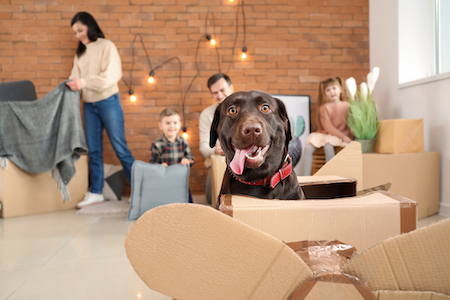
1. Prepare your dog before the move.
Once you start moving things around, in and out of the house and packing up boxes, your dog will know something is up. While there’s nothing scary about cardboard boxes and rolls of packing tape, that doesn’t mean your dog won’t be afraid of what is happening around her.
It’s a great idea to leave out boxes and supplies for your dog before you start packing. Let your furry friend have the chance to sniff and investigate the strange items that have appeared inside her territory. Your dog is likely to be less panicked when you start packing boxes because she has had time to get used to them.
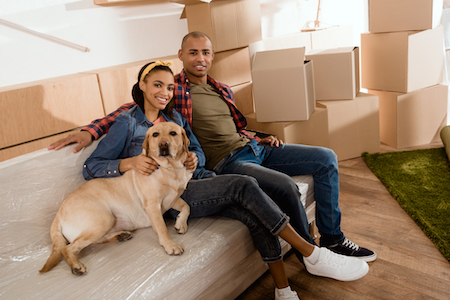
2. Stick to your dog’s routine.
It’s essential to be mindful of your dog’s needs and keep her happy, even when preparing for a big move. Stick to the normal routine you have established with your dog. If you walk your dog every morning at 7 AM, continue to do so. Don’t change that pattern if you spend time playing fetch in the backyard after work. Your dog depends on you to set the structure of her day. If that structure suddenly evaporates, she will understandably be caught off guard.
It can be difficult when you are packing to move because there are so many demands to handle. However, your dog needs to be a priority here, no matter how pressed for time, you may be. Keep mealtimes and potty breaks on schedule to ensure a smooth move for both you and your pup. This consistency will make them feel safe rather than scared.

3. Provide lots of exercise.
A tired dog is a happy dog. Exercise improves your dog’s mental and physical health. She will be less likely to feel stressed when she has spent all that nervous energy during a healthy activity. Keeping your dog’s stress levels down is essential for their health and happiness, and exercise is the perfect way to achieve that state of healthy exhaustion. Take time to walk her longer and play outside at the dog park for longer around all the packing. It will do your mental state some good, too!
If you are pressed for time and can’t add to your dog’s exercise routine, consider taking her to a doggy daycare a couple of days a week or asking neighbors, family members, or professional dog walkers to help keep your furkid happily engaged in physical motion. Exercise is vital for dogs, even more so if your pooch has too much energy and needs an outlet, so don’t skimp on your pup’s activities.
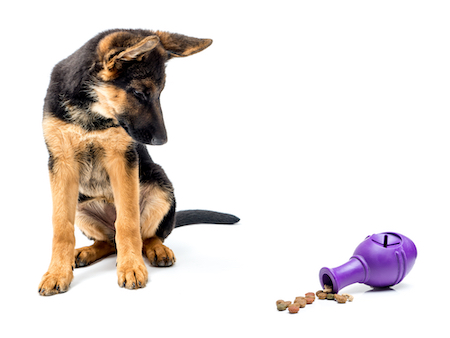
4. Keep your dog’s mind busy.
Do you want to exercise your dog but are too busy labeling boxes and making moving arrangements? On those hectic days when you can’t get your dog outside more than usual, you can use brain games to keep her occupied for hours. For example, place their favorite toys or treats behind the taped boxes for her to find. You can also try picking up some treat-filled puzzles that will challenge your dog to use her mind and mouth to “solve” the game.
If your dog is a chewer, look for heavy-duty toys, such as a Kong, to stuff with treats or frozen peanut butter. Your dog will love the treat, and the toy will fully engage her mental stimulation.
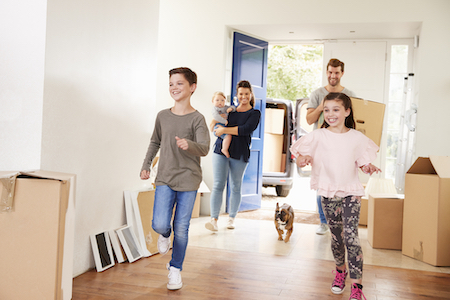
5. Use anxiety aids.
There are many viable and available anxiety aids for pet parents to use should their dog have difficulty adjusting to the moving process. A stress-reducing calming collar, CBD treats, or a Thundershirt or similar weighted jacket may help calm your dog’s anxiety during the stressful move. Contact your veterinarian about safe prescription medications, such as Diazepam and Alprazolam that will keep your dog calm.
To ensure that these aids are effective, test them before you move. Don’t wait until the day of the move to try anything new on your dog.
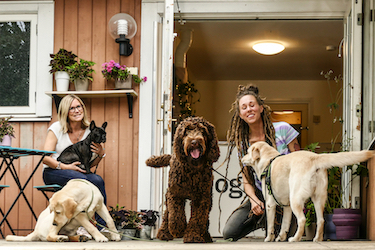
6. Take your dog somewhere else on moving day.
On moving day, make arrangements for your dog to be elsewhere. A stressed-out pooch is often right under your feet when she’s not supposed to be. This scenario could cause serious problems when heavy objects like furniture or appliances are moved. Your dog’s safety may be at risk. We all know how stressful moving can be. Even if your dog is taking the move and accompanying activity relatively well, the situation is probably still stressful to her.
Ask a friend or family member to watch your furkid that day, or take your dog to a local boarding facility she is already familiar with. Contact dog walking or dog sitting companies to hire a professional who can take your dog for the day. You can also set up a meet and greet visit beforehand so your dog gets acquainted with the sitter before moving day. It will help you not to worry about your dog during a hectic moving day. Whatever your choice, it’s essential to keep your dog’s day stress-free, even if yours is not.
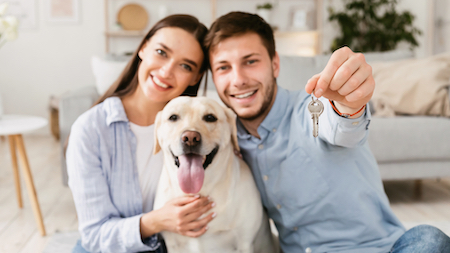
7. Be patient and empathetic.
Moving with a dog can be hard on both of you. There are many reasons dogs may misbehave, and moving is one of them. The stress makes them feel anxious about the changes around them. Your dog does not understand the reasons behind the move, but you do. Don’t be surprised if your dog still acts up by barking, whining, or exhibiting extra neediness during the moving process or once you are in the new house.
While your dog may not be able to express herself the same way humans do, she still needs your empathy and understanding. Allowing her stressful behavior to affect how you communicate with her will lead to negative results. To counter negative behaviors, use positive behavior reinforcement techniques. If you ever find yourself angry or frustrated with your dog’s actions, it is important to remember that losing your temper will not improve the situation. If your dog is still exhibiting high-stress levels after a month in the new home, contact your vet for advice. You may also want to reach out to an expert rewards-based trainer for assistance.
Stay calm and get pet insurance.
When you move, your dog will always experience some level of stress. But you can do some things to reduce the amount and intensity she feels during this process, and pet insurance can help. Suppose your pup does need an examination or a prescription for stress-reducing medications. In that case, your pet insurance policy can reimburse you those costs based on the tier of your chosen plan. And, if your pet suffers from an injury during the moving process, your insurance policy can cover most of that bill.
Move with confidence, and get a free pet insurance quote from Pet Insurance Review. We will contact all major providers and find a plan that works for you and your dog.
References:
- Sit Means Sit. (2019). Why Dogs Need Stability. Retrieved from https://sitmeanssit.com/dog-training-mu/atlanta-dog-training/why-dogs-need-stability/
- Mood, A. (2019). How To Tell If Your Dog Is Stressed. Retrieved from https://www.akc.org/expert-advice/advice/how-to-tell-if-your-dog-is-stressed/
- Dr. Phillips Animal Hospital. (2021). How An Active Lifestyle Reduces Your Dog’s Fearlessness. Retrieved from https://drphillipsanimalhospital.com/2021/06/24/how-an-active-lifestyle-reduces-your-dogs-fearfulness/
- King, A. (2022). 10 Brain Games to Keep Your Dog Mentally Stimulated. Retrieved from https://www.wideopenpets.com/10-games-keep-dog-mentally-stimulated/
- Osmanski, S. (2021). 10 of the Best Calming Products to Ease Your Dog’s Anxiety. Retrieved from https://www.newsweek.com/10-best-calming-products-ease-your-dogs-anxiety-1627230
- Knierim, A. (2021). The 8 Best Dog Sitting Services of 2022. Retrieved from https://www.thesprucepets.com/best-dog-sitting-services-5080107
- Valentini, K. (2020). 6 Easy Tips to Train Your Dog With Positive Reinforcement. Retrieved from https://www.dailypaws.com/dogs-puppies/dog-training/basic/positive-reinforcement-dog-training
The information contained on this blog is intended for informational and educational purposes only and should not be construed as medical advice. It is not a substitute for professional veterinary care. Always consult with your veterinarian before making any changes to your pet's health care or treatment plan.
The authors of this blog are not veterinarians and do not claim to be experts in pet health. The information provided here is based on our own experiences and research, as well as information from reputable sources. However, we cannot guarantee the accuracy or completeness of this information.
We encourage you to do your own research and consult with your veterinarian before making any decisions about your pet's health.
Previous post
Laser Therapy for PetsNext post
Keeping a Senior Cat Active and HealthyCompare top pet insurance providers plans.
Enter your dog’s age in years and months to calculate their age equivalent to human years.
Calculate your dog’s ageEnter your cat’s age in years and months to calculate their age equivalent to human years.
Calculate your cat’s age